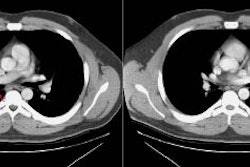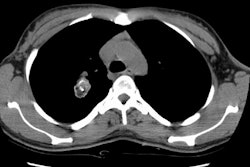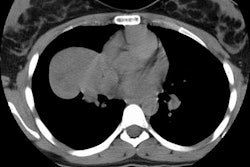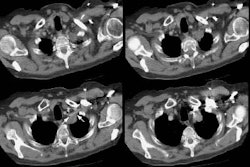- N Engl J Med 2000 Jul 27;343(4):254-61
- Preoperative staging of non-small-cell lung cancer with positron-emission
tomography.
Pieterman RM, van Putten JW, Meuzelaar JJ, Mooyaart EL, Vaalburg W, Koeter GH, Fidler V, Pruim J, Groen HJ
- BACKGROUND: Determining the stage of non-small-cell lung cancer often requires multiple
preoperative tests and invasive procedures. Whole-body positron-emission tomography (PET)
may simplify and improve the evaluation of patients with this tumor. METHODS: We
prospectively compared the ability of a standard approach to staging (computed tomography
[CT], ultrasonography, bone scanning, and, when indicated, needle biopsies) and one
involving PET to detect metastases in mediastinal lymph nodes and at distant sites in 102
patients with resectable non-small-cell lung cancer. The presence of mediastinal
metastatic disease was confirmed histopathologically. Distant metastases that were
detected by PET were further evaluated by standard imaging tests and biopsies. Patients
were followed postoperatively for six months by standard methods to detect occult
metastases. Logistic-regression analysis was used to evaluate the ability of PET and CT to
identify malignant mediastinal lymph nodes. RESULTS: The sensitivity and specificity of
PET for the detection of mediastinal metastases were 91 percent (95 percent confidence
interval, 81 to 100 percent) and 86 percent (95 percent confidence interval, 78 to 94
percent), respectively. The corresponding values for CT were 75 percent (95 percent
confidence interval, 60 to 90 percent) and 66 percent (95 percent confidence interval, 55
to 77 percent). When the results of PET and CT were adjusted for each other, only PET
results were positively correlated with the histopathological findings in mediastinal
lymph nodes (P<0.001). PET identified distant metastases that had not been found by
standard methods in 11 of 102 patients. The sensitivity and specificity of PET for the
detection of both mediastinal and distant metastatic disease were 95 percent (95 percent
confidence interval, 88 to 100 percent) and 83 percent (95 percent confidence interval, 74
to 92 percent), respectively. The use of PET to identify the stage of the disease resulted
in a different stage from the one determined by standard methods in 62 patients: the stage
was lowered in 20 and raised in 42. CONCLUSIONS: PET improves the rate of detection of
local and distant metastases in patients with non-small-cell lung cancer.
- PMID: 10911007, UI: 20350563
Tumor > Malignant > Lungcancer
Latest in Tumor
Tumor > Benign > Inflammatory myofibroblastic tumor
October 19, 2020
Tumor > Malignant > Lungcancer > Staging
February 22, 2009
Tumor > Benign > Mesenchymal hamartoma
October 30, 2008
Tumor > Benign > Leiomyoma
October 30, 2008



